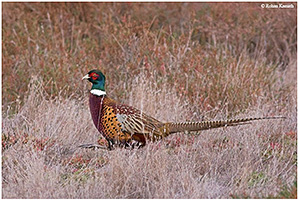Population Dynamics |
|
|---|---|

photograph of Ring-necked Pheasant by Rohan Kamath |
The "dynamics" of bird populations, the ways in which their numbers grow and shrink as time goes by, are controlled by the same general factors that control the size of human populations. An avian or human population has two kinds of input -- birth (natality) and immigration. And each population has the same two outputs -- death (mortality) and emigration. If the inputs are greater than the outputs, the population will grow. If the outputs are higher than the inputs, it will shrink. If the two are in balance, the population size will not change, or as ecologists would say, the population "density" is constant. Population density is, technically, the number of individuals per unit area. But since a population normally occupies a limited area of suitable habitat, its size increases, decreases, or remains stable along with its density. |
|
In an average lifetime, the
average female in each bird population lays many more eggs
than are required to replace her and her mate, if the chicks
from all of her eggs were to mature into reproducing adults.
Mortality, however, intervenes. Eggs are destroyed by nest
robbers, chicks starve, freeze, are killed by disease or
parasites, or are carried off by predators, juveniles are
devoured by hawks, crash into obstacles on migration, or die
of cold or starvation in their first winter. As a result, in
spite of their large reproductive potential, populations are
often more or less stable. Over the long run each female in
one generation of a bird population is replaced in the next
generation by, on the average, just one female. If she were
replaced by two females, and there were one generation per
year, and if each bird weighed a pound, then in less than a
century the bird population would outweigh Earth. Such is
the power of exponential increase. If each female were
replaced by much less than one female each generation, then
the population would soon be extinct. In the following
example, the constraints of mortality have been relaxed, and
one can see a bird population begin expansion in the
direction of Earth weight. In 1937, two male and six female Ring-necked Pheasants were introduced onto a 450-acre island off the coast of Washington State. The island had not previously had a pheasant population, but with superabundant food and few predators, the population exploded. Even though many birds died each winter, the original flock of eight became a horde of nearly two thousand within six breeding seasons. During that period, however, the rate of growth of the population was gradually slowed. This decrease in growth rate was probably due, at least in part, to diminishing space for male territories and possibly to decreased food supply, leading to higher juvenile mortality. Limited space for territories may often put a cap on the size of bird populations. In his well-known study of Florida Scrub jays, Glen Woolfenden found that the density of breeding pairs remained quite constant. In a stretch of about 550 acres of prime habitat, there was very close to one pair per 25 acres for each of the nine years from 1971 to 1979. In contrast, at the start of the breeding season in those same years, the overall density of jays in the area was three to four times as great. Interestingly, there was no relationship between the density of jays just before the breeding season and the breeding density. Apparently the habitat is saturated with breeding pairs; surplus mature birds must wait until space opens for them, often in the interim helping at the nests of their parents. Florida Scrub Jay territories tend to be relatively constant in size, but those of other birds may vary. When territorial males are abundant, territories may be small. If, in contrast, few males seek territories, territories may expand -- and if a severe winter or some other factor significantly reduces the number of potentially breeding males, parts of the habitat that previously were used for territories will remain unoccupied in the spring. These phenomena were well described in a classic study of Song Sparrows by pioneer American ornithologist Margaret Morse Nice. She carefully mapped territories in one locality in Ohio from 1930 to 1935, inclusive, as shown in the accompanying figure (in each map the Olentangy River is the left-hand border of the map, a street the right, the other straight lines are dikes; the scale line represents 200 yards). The number of males fluctuated between 17 (much habitat unoccupied, territories large) and 44 (most habitat occupied, territories small). The difference can be seen easily in the right-hand pair of maps. Note the five small territories along the southern dike at the bottom of the upper map and the four larger ones at the bottom of the lower map. |
|
| SEE:
Territoriality;
Irruptions;
Site Tenacity;
Avian Invaders;
Cooperative Breeding. Copyright ® 1988 by Paul R. Ehrlich, David S. Dobkin, and Darryl Wheye. |
|